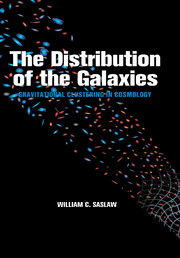Book contents
- Frontmatter
- Contents
- Prologue
- Part I Historical
- Part II Descriptions of Clustering
- Part III Gravity and Correlation Functions
- Part IV Gravity and Distribution Functions
- 21 General Properties of Distribution Functions
- 22 Dynamics of Distribution Functions
- 23 Short Review of Basic Thermodynamics
- 24 Thermodynamics and Gravity
- 25 Thermodynamic Formulation of the Cosmological Many-Body Problem
- 26 The Functional Form of b(n̄, T)
- 27 Derivation of the Spatial Distribution Function
- 28 Properties of the Spatial Gravitational Quasi-Equillibrium Distribution
- 29 The Velocity Distribution Function
- 30 Evolution of the GQED
- Part V Computer Experiments for Distribution Functions
- Part VI Observations of Distribution Functions
- Part VII Future Unfoldings
- Bibliography
- Index
25 - Thermodynamic Formulation of the Cosmological Many-Body Problem
Published online by Cambridge University Press: 19 January 2010
- Frontmatter
- Contents
- Prologue
- Part I Historical
- Part II Descriptions of Clustering
- Part III Gravity and Correlation Functions
- Part IV Gravity and Distribution Functions
- 21 General Properties of Distribution Functions
- 22 Dynamics of Distribution Functions
- 23 Short Review of Basic Thermodynamics
- 24 Thermodynamics and Gravity
- 25 Thermodynamic Formulation of the Cosmological Many-Body Problem
- 26 The Functional Form of b(n̄, T)
- 27 Derivation of the Spatial Distribution Function
- 28 Properties of the Spatial Gravitational Quasi-Equillibrium Distribution
- 29 The Velocity Distribution Function
- 30 Evolution of the GQED
- Part V Computer Experiments for Distribution Functions
- Part VI Observations of Distribution Functions
- Part VII Future Unfoldings
- Bibliography
- Index
Summary
Many shall run to and fro,
and knowledge shall be increased.
Daniel 12:4We start with the simplest form of the cosmological many-body problem: the one Bentley posed to Newton (see Chapter 2). In its modern version it asks “If the universe were filled with an initial Poisson distribution of identical gravitating point masses, how would their distribution evolve?” This is clearly an interesting physical problem in its own right, and it provides the simplest model for galaxy clustering in the expanding universe. If we can solve it, other complications such as a range of masses, different initial conditions, galaxy merging, and inhomogeneous intergalactic dark matter may be added to account for observed galaxy clustering. Actually, we will find that these complications are secondary. The simple gravitational cosmological manybody problem contains the essential physics of the observed galaxy distributions.
To formulate the problem thermodynamically in a solvable way, we first examine why the mean gravitational field is not dynamically important and why extensivity is a good approximation. This leads to a derivation of the form of the energy and pressure equations of state. In turn, this derivation provides insight into the requirements for quasi-equilibrium. To complete the basic description, equivalent to finding the third equation of state, Chapter 26 develops very general physical properties of these gravitating systems. This closely follows the analyses by Saslaw and Fang (1996).
- Type
- Chapter
- Information
- The Distribution of the GalaxiesGravitational Clustering in Cosmology, pp. 306 - 318Publisher: Cambridge University PressPrint publication year: 1999

